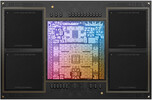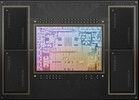Apple M2 Max vs Intel Core 2 Duo SL9600 vs Apple M2 Pro
Apple M2 Max
► remove from comparison
The Apple M2 Max is a System on a Chip (SoC) from Apple that is found in the early 2023 MacBook Pro 14 and 16-inch models. It offers all 12 CPU cores available in the chip divided in eight performance cores (P-cores) and four power-efficiency cores (E-cores). The E-cores clock with up to 3.4 GHz, the P-Cores up to 3.7 GHz (mostly 3.3 GHz in multi-threaded workloads and 3.4 GHz in single threaded).
The big cores (codename Avalanche) offer 192 KB instruction cache, 128 KB data cache, and 36 MB shared L2 cache (up from 24 MB in the M1 Pro). The four efficiency cores (codename Blizzard) are a lot smaller and offer only 128 KB instruction cache, 64 KB data cache, and 4 MB shared cache. CPU and GPU can both use the 49 MB SLC (System Level Cache).
The unified memory (32, 64, or 96 GB LPDDR5-6400) next to the chip is connected by a 512 Bit memory controller (400 GB/s bandwidth) and can be used by the GPU and CPU.
The CPU performance should be quite similar to the M2 Pro as only the higher memory bandwidth and bigger L3 cache could make a difference for some workloads.
The integrated graphics card in the M1 Max offers a 30-core GPU or a GPU with all 38 cores.
Furthermore, the SoC integrates a fast 16 core neural engine (faster than M1 Max), a secure enclave (e.g., for encryption), a unified memory architecture, Thunderbolt 4 controller, an ISP, and media de- and encoders (including ProRes).
The M2 Max is manufactured in 5 nm at TSMC (second generation) and integrates 40 billion transistors. The power consumption of the CPU part is up to 36 Watt according to powermetrics. When fully loading the CPU and GPU cores, the chip uses up to 89 Watt and the CPU part is limited to 25 Watt.
Intel Core 2 Duo SL9600
► remove from comparisonThe Intel Core 2 Duo SL9600 is a low power laptop processor for small and slim laptops. It features the full 6 MB level 2 cache and all features of the Penryn core (e.g. VT-x and Trusted Execution). Due to the large cache, the CPU shows a good performance for the small clock rate. However, in the MacBook Air, the CPU throttled very often, leading to the slower benchmarks in our database.
Compared to other Core 2 Duo models, the C2D SL9600 only supports the socket BGA956 and is soldered in the MacBook Air models.
Apple M2 Pro
► remove from comparison
The Apple M2 Pro is a System on a Chip (SoC) from Apple that is found in the early 2023 MacBook Pro 14 and 16-inch models. It offers all 12 cores available in the chip divided in eight performance cores (P-cores) and four power-efficiency cores (E-cores). The E-cores clock with up to 3.4 GHz, the P-Cores up to 3.7 GHz (mostly 3.3 GHz in multi-threaded workloads and 3.4 GHz in single threaded).
The big cores (codename Avalanche) offer 192 KB instruction cache, 128 KB data cache, and 36 MB shared L2 cache (up from 24 MB in the M1 Pro). The four efficiency cores (codename Blizzard) are a lot smaller and offer only 128 KB instruction cache, 64 KB data cache, and 4 MB shared cache. CPU and GPU can both use the 24 MB SLC (System Level Cache).
The unified memory (16 or 32 GB LPDDR5-6400) next to the chip is connected by a 256 Bit memory controller (200 GB/s bandwidth) and can be used by the GPU and CPU.
Apple states that the M2 Pro has a 25% higher performance than the M1 Pro in Xcode compiling.
The integrated graphics card in the M1 Pro offers all 19 cores.
Furthermore, the SoC integrates a fast 16 core neural engine (faster than M1 Pro), a secure enclave (e.g., for encryption), a unified memory architecture, Thunderbolt 4 controller, an ISP, and media de- and encoders (including ProRes).
The M2 Pro is manufactured in 5 nm at TSMC (second generation) and integrates 40 billion transistors.
| Model | Apple M2 Max | Intel Core 2 Duo SL9600 | Apple M2 Pro | ||||||||||||||||||||||||||||||||
| Series | Apple M2 | Intel Core 2 Duo | Apple M2 | ||||||||||||||||||||||||||||||||
| Series: M2 |
|
| |||||||||||||||||||||||||||||||||
| Clock | 2424 - 3696 MHz | 2130 MHz | 2424 - 3504 MHz | ||||||||||||||||||||||||||||||||
| L1 Cache | 3.3 MB | 128 KB | 3.3 MB | ||||||||||||||||||||||||||||||||
| L2 Cache | 36 MB | 6 MB | 36 MB | ||||||||||||||||||||||||||||||||
| L3 Cache | 48 MB | 24 MB | |||||||||||||||||||||||||||||||||
| Cores / Threads | 12 / 12 | 2 / 2 | 12 / 12 | ||||||||||||||||||||||||||||||||
| TDP | 79 Watt | 17 Watt | |||||||||||||||||||||||||||||||||
| Transistors | 67000 Million | 410 Million | 40000 Million | ||||||||||||||||||||||||||||||||
| Technology | 5 nm | 45 nm | 5 nm | ||||||||||||||||||||||||||||||||
| Features | ARMv8 Instruction Set | Enhanced Speedstep, Intel VT, TXT, Intel64 | ARMv8 Instruction Set | ||||||||||||||||||||||||||||||||
| iGPU | Apple M2 Max 38-Core GPU | Apple M2 Pro 19-Core GPU | |||||||||||||||||||||||||||||||||
| Architecture | ARM | x86 | ARM | ||||||||||||||||||||||||||||||||
| Announced | |||||||||||||||||||||||||||||||||||
| Codename | Penryn | ||||||||||||||||||||||||||||||||||
| FSB | 1066 | ||||||||||||||||||||||||||||||||||
| Voltage | 1.05-1.15 V | ||||||||||||||||||||||||||||||||||
| Die Size | 107 mm2 | ||||||||||||||||||||||||||||||||||
| max. Temp. | 105 °C | ||||||||||||||||||||||||||||||||||
| Socket | BGA956 | ||||||||||||||||||||||||||||||||||
| $316 U.S. | |||||||||||||||||||||||||||||||||||
| Manufacturer | ark.intel.com |
Benchmarks
Average Benchmarks Apple M2 Max → 0% n=0
Average Benchmarks Intel Core 2 Duo SL9600 → 0% n=0
Average Benchmarks Apple M2 Pro → 0% n=0
* Smaller numbers mean a higher performance
1 This benchmark is not used for the average calculation













